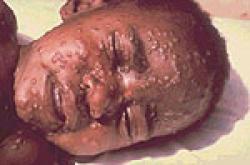
Published date
13 February 1713
Introduction:
Smallpox epidemic strikes the refreshment station at the Cape, after arriving with the crew on a Dutch ship. The disease wreaks irreparable havoc amongst the indigenous and colonist population of the Cape Peninsula and adjacent interior. Hardest hit are the indigenous Khoisan people. They appear to have much less resistance to the disease than the slaves and the colonists have and suffer huge losses to their numbers.
The Smallpox Epidemic of 1713
On 13 February 1713 something as unlikely as the dirty linen of the crew of a Dutch ship that had stopped at the refreshment station of the Cape, wreaked irreparable havoc amongst the indigenous and colonist population of the Cape Peninsula and adjacent interior.
The crew, under the command of Commissioner Johannes van Steeland, had come down with smallpox, a disease that was fatal at the time. Their clothing and other linen were sent to the slave lodge of the Dutch East India Company (VOC) to be laundered. Within weeks the Company slaves were succumbing at the rate of about eight persons a day to the disease. White colonists were also beginning to be affected. By May 1713 the smallpox disease had reached pandemic proportions. The dead could not be buried in coffins, as there was a shortage of wood at the Cape.
By June 1713 the epidemic was largely contained on the Cape Peninsula. However, it spread into the adjacent interior. The white settler farmers were the first to be affected. Farming came to a standstill. Emergency supplies had to be imported from Batavia. However, at the end of 1713 the disease was no longer a threat to the white population. Nevertheless approximately a quarter of the colonist population had died. As soon as the epidemic was over for the European people, the Cape authorities ordered the immediate reconstruction of the affected areas.
However, the indigenous Khoisan people were not as fortunate. They appeared to have much less resistance to the disease than the slaves and the colonists had. The disease was foreign to the Khoikhoi. Hence they had no recourse to indigenous medicines that could be used for this disease. It appears that they felt that the colonisers were actively visiting this evil and death upon them. So the Khoi fled the Peninsula with all their belongings in the hope of escaping the smallpox. But this was in vain: even as they took ill they died almost immediately. The unaffected Khoi groups whom they encountered in the interior to which they had fled, were terrified of the consequences of contact, and consequently killed the fleeing Khoi.
By February 1714 the few Khoi survivors reported to the Governor of the Cape that not even ten percent of the original Khoi population of the south-western Cape had survived the epidemic. Whole clans were annihilated in most instances. In other instances, the few survivors could not reconstruct a coherent clan as even the captains had died. For this reason, the indigenous clan names were lost. Instead the Khoikhoi became known by the derogatory term "Hottentots".
As the smallpox epidemic decimated most of the Khoikhoi, what remained of their economic strength after colonisation was further eroded. Settler farmers moved into areas previously inhabited by the Khoi and started a new existence for themselves with the aid of the Cape government.
References
Potgieter, D.J. et al. (eds) (1970). Standard Encyclopaedia of Southern Africa, Cape Town: NASOU, 4, p. 378.